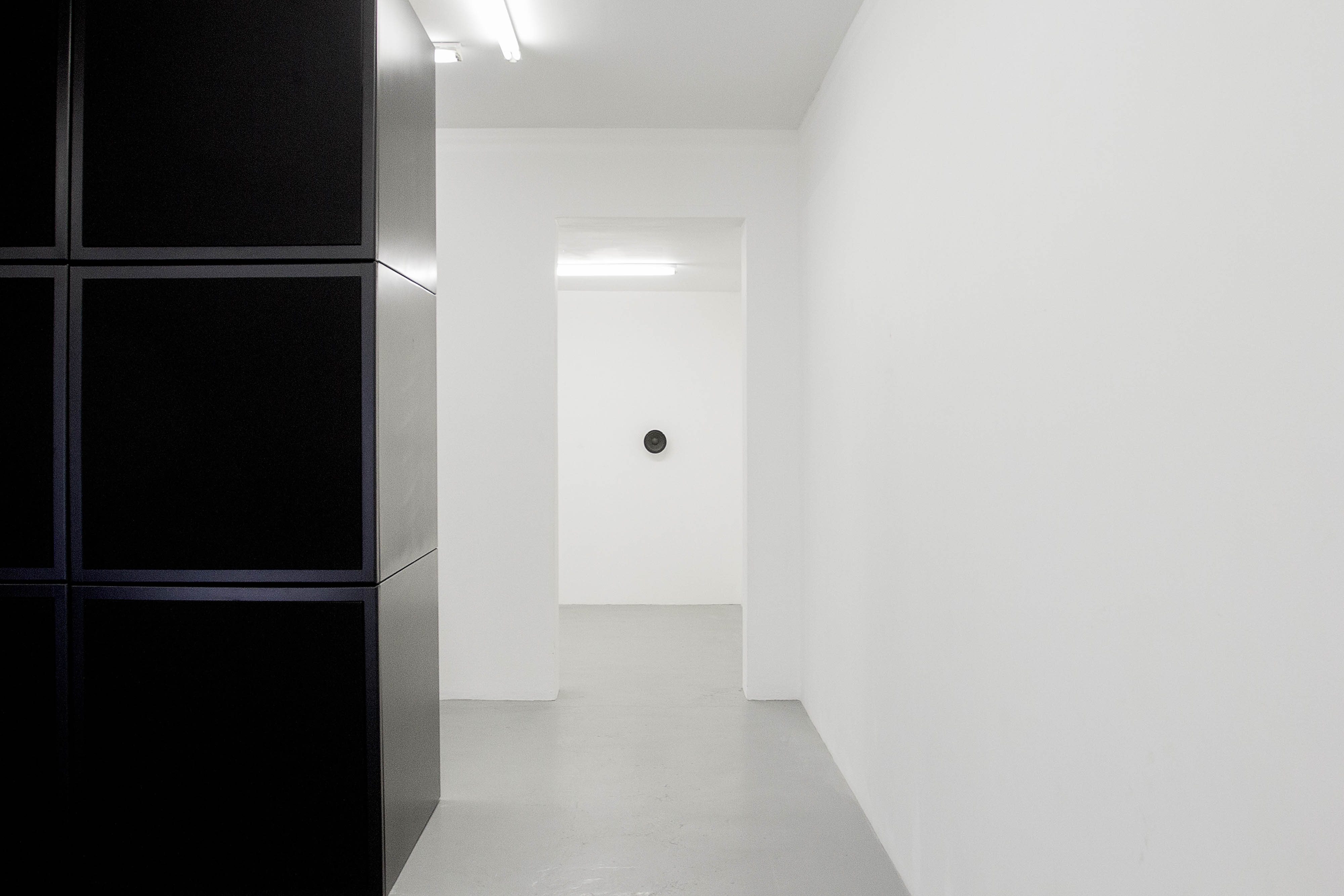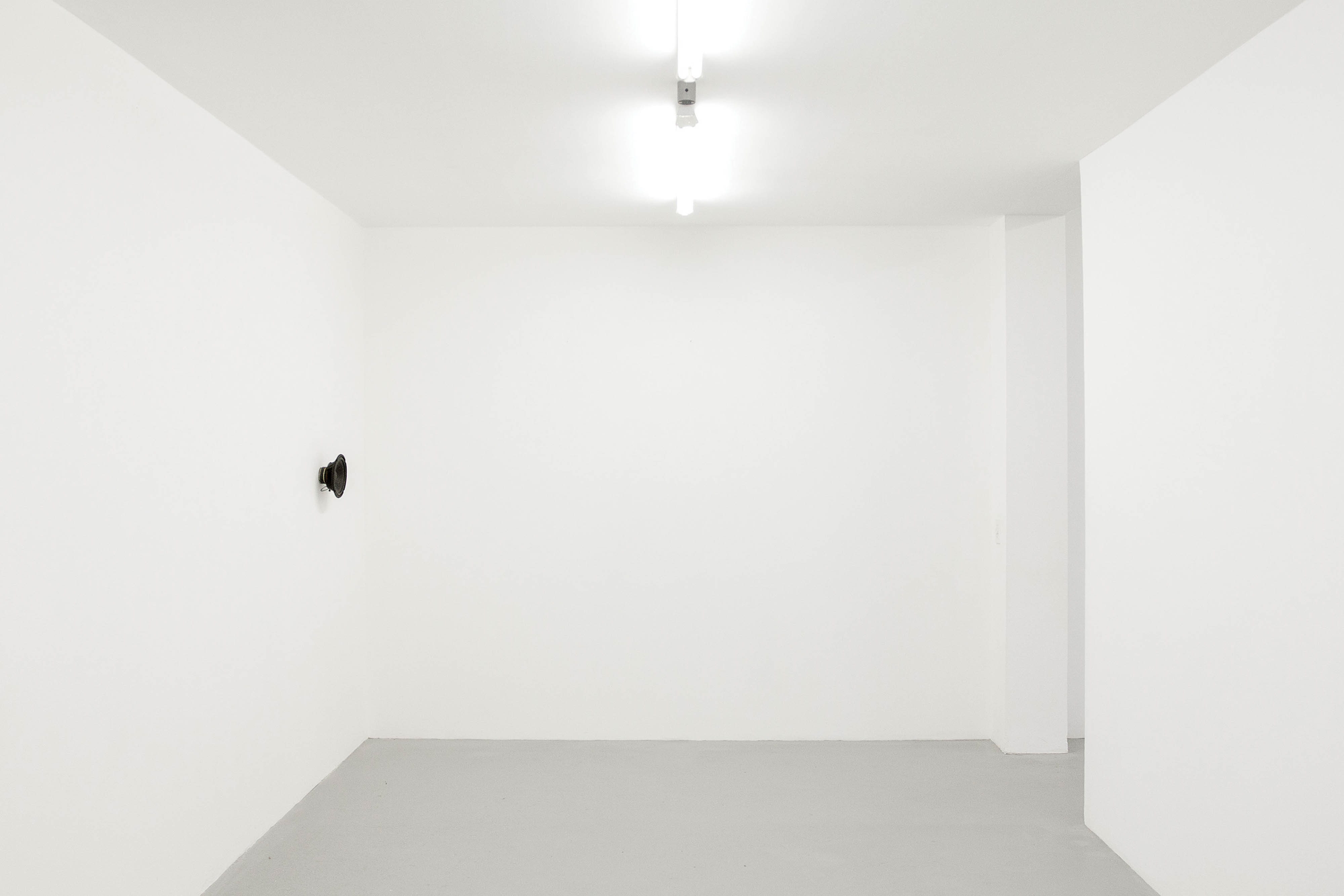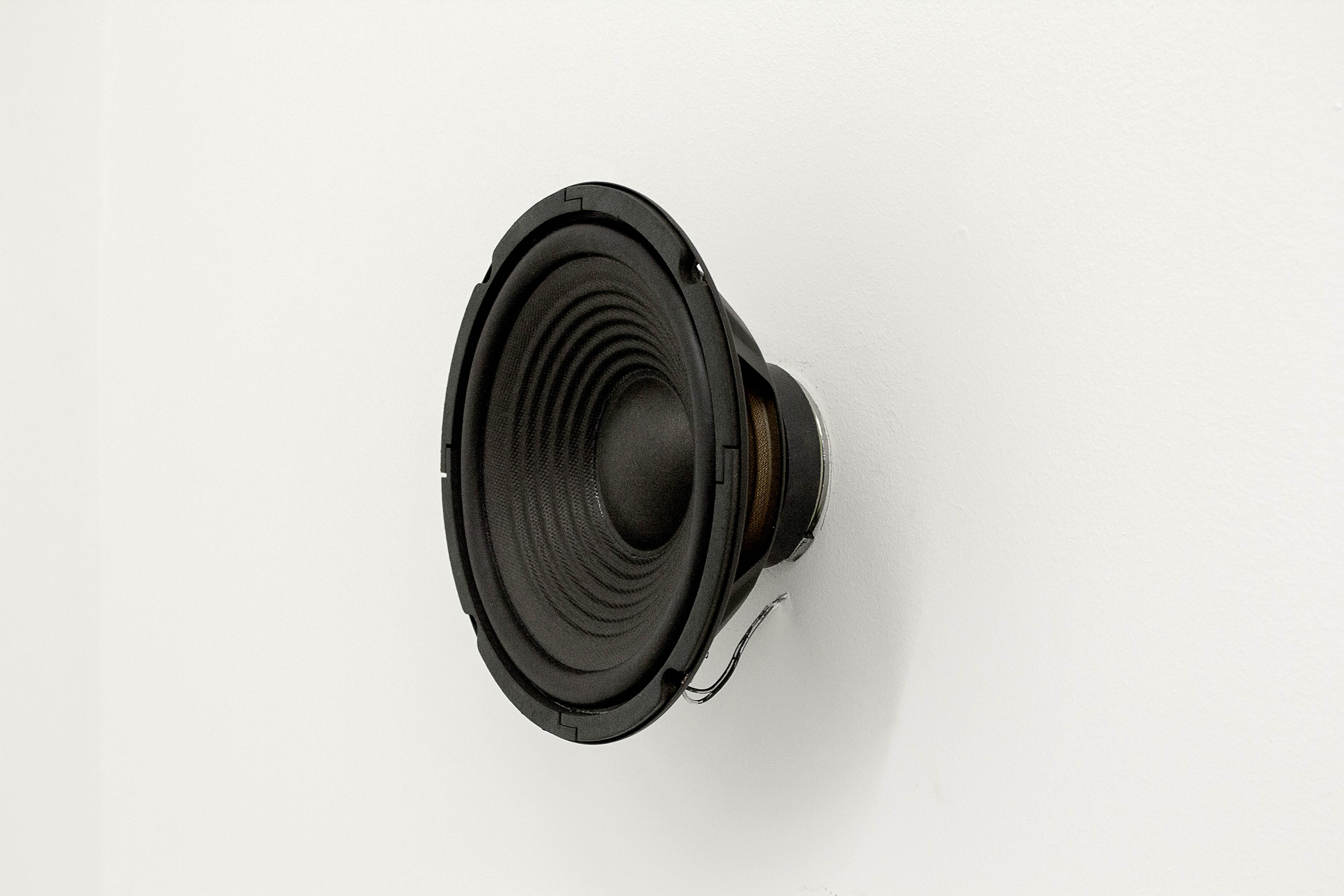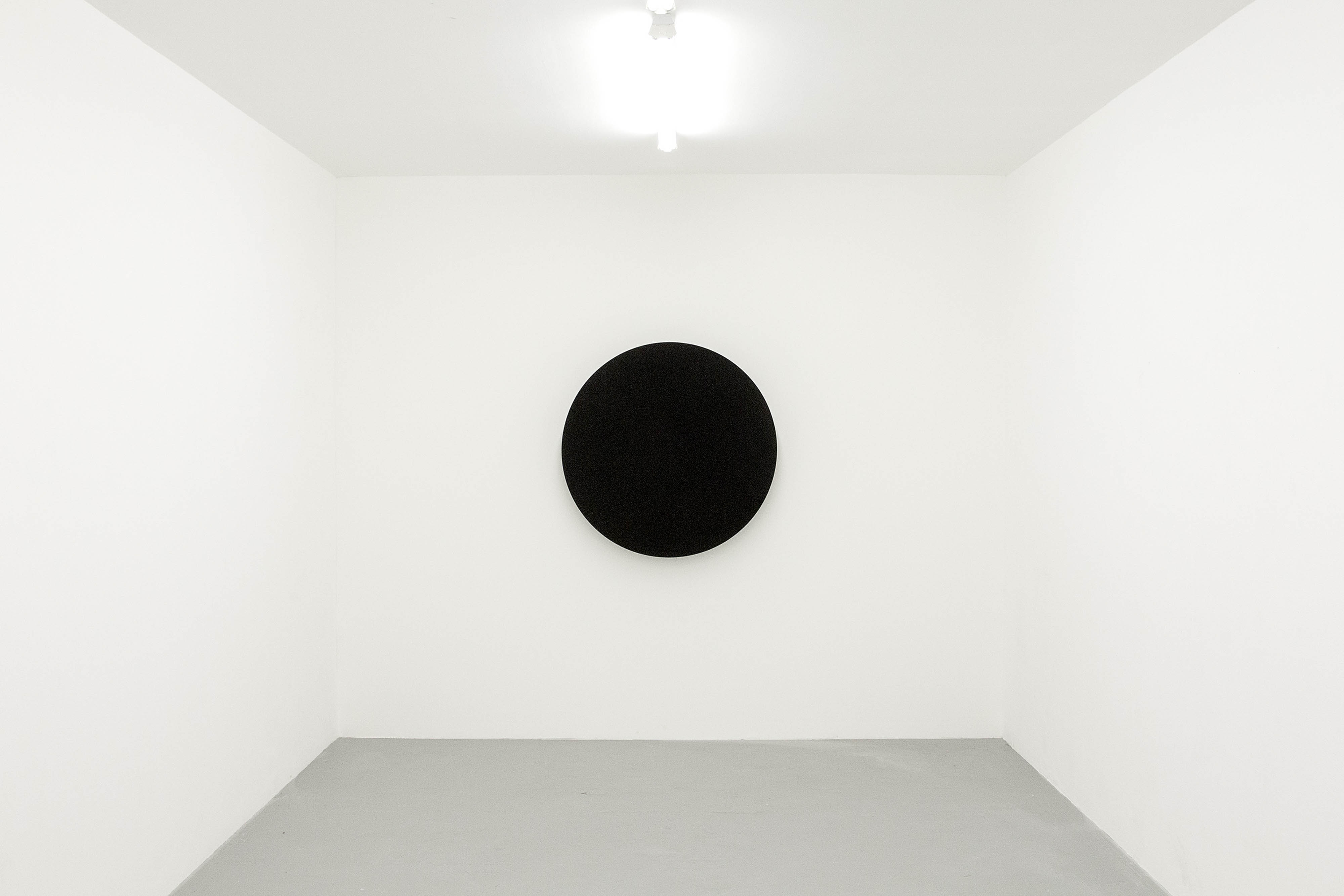








Ecstatic Interference, James Webb’s latest solo exhibition at blank projects conjures a syzygy of unspoken inter-relational dynamics, somatic energy, and psychological undercurrents. The exhibition will feature 3 new sound installations: a multi-channel, monolithic speaker stack, a stereo array, and a single-channel Holosonic audio beam. The show is composed together to create a dynamic body of aural and minimalist, monochrome physical forms.
Three new sound installations are presented in this exhibition: Untitled (with the sound of its own making), a solar-powered, multi-channel loudspeaker system broadcasting recordings of hands beating on doors; All that is unknown, featuring audio recordings of two hearts beating, installed in two speakers separated by the length of a room; and Threnody, where the isolated vocal track of Helter Skelter (The Beatles, 1968) was reversed and given to the vocalist Zami Mdingi to sing as such, and broadcast from a circular, hyper-directional speaker visually echoing Kazimir Malevich’s Black Circle (1915).
The exhibition title, Ecstatic Interference, a double reading on the term for radio noise (static interference), is here reimagined as a form of transcendental intervention and joyous interruption. Visually, the works are monochromatic circular and square speaker boxes: minimalist shapes in a white cube. Aurally, the exhibition has been staged around the dynamics of rhythm and transmission, as well as the subliminal image of a body through the aural presence of the hand, heart and mouth.
Writing on Webb’s practice, the artist and theorist Brandon LaBelle, says, “the works of James Webb circulate around a complex mixture of emotional and affective states; of longing and despair, of the ecstatic and of hopefulness, states of bodies and minds that move throughout his practice to raise questions of individuality and community, belonging and displacement, fragmentation and recuperation. Webb consistently and methodically captures a multitude of figures and forms – bodies, and especially voices of contemporary existence at their most tenuous. Yet what he reveals, through acts of recording and of transmitting, is how such tenuousness is often so profound.” (LaBelle, 2015)1
In Untitled (with the sound of its own making), Webb worked with various drummers who used their hands to activate doors as a sonic material, conceptually evoking images of access, escape, and agency. The audio is housed in a monolithic loudspeaker stack made up of 15 black cubes, and is solar-powered, allowing the artwork to be independent from the municipal grid, and run constantly. The title alludes to Robert Morris’s seminal Box with the Sound of its own Making (1961), and is here reconsidered as an undefined state with the sound of its own becoming. Participating drummers include Adrian Langeveld (The Summer Underground), Barry van Zyl (Johnny Clegg band), Bronwen Clacherty (Tholakele Project), Caitlin Mkhasibe (Morning Pages), Jason Jardim (Wildernessking), Ross Campbell (Benguela, Urban Creep), Thokozani Mhlambi, and William Mosima (Sonic Mmabolela). The speaker box was designed and constructed by Brett Netherton, and the solar power was generously sponsored by PVI Solar.
In All that is unknown, a stereo array of speakers pulse with recordings of two human heartbeats; one per speaker. The naked speaker cones are placed apart, facing each other through a doorway, with a distance of 10m between them. Referencing signs of life, the pair pulse incessantly at the threshold of audibility within the cacophony of the accompanying works on the exhibition, their rhythms phasing in and out with each other like a hushed call and response, only accessible to the audience by touching the speakers to register the vibrations therein.
In Threnody, Paul McCartney’s vocal take for the proto-heavy metal song, Helter Skelter (The Beatles, 1968) was isolated and then reversed so as to create a backwards speech adrift from its musical accompaniment. This sonic artefact was scrutinised and used as the guide track for the vocalist Zami Mdingi to sing. Webb worked with Mdingi, and ethnomusicologist, Cara Stacey, to transcribe the inverted phonetics, melodies and lyrics – occasionally reimagining the new words in an isiXhosa framework for Mdingi to best articulate. The result revealed itself as a glossolalic lamentation, quite different from the tumultuous confusion suggested in the original song and its associations to Charles Manson. The artwork is broadcast from a hyper-directional speaker visually echoing Kazimir Malevich’s Black Circle (1915), and projecting the sound out like a beam into the space.
1LaBelle, B. 2015. The Precarious Body, Xenagogue, Hordaland Kunstsenter, Norway.
—
Click to listen to extracts of the audio on SoundCloud (headphones recommended):
Untitled (with the sound of its own making)
All that is unknown
Threnody
Three new sound installations are presented in this exhibition: Untitled (with the sound of its own making), a solar-powered, multi-channel loudspeaker system broadcasting recordings of hands beating on doors; All that is unknown, featuring audio recordings of two hearts beating, installed in two speakers separated by the length of a room; and Threnody, where the isolated vocal track of Helter Skelter (The Beatles, 1968) was reversed and given to the vocalist Zami Mdingi to sing as such, and broadcast from a circular, hyper-directional speaker visually echoing Kazimir Malevich’s Black Circle (1915).
The exhibition title, Ecstatic Interference, a double reading on the term for radio noise (static interference), is here reimagined as a form of transcendental intervention and joyous interruption. Visually, the works are monochromatic circular and square speaker boxes: minimalist shapes in a white cube. Aurally, the exhibition has been staged around the dynamics of rhythm and transmission, as well as the subliminal image of a body through the aural presence of the hand, heart and mouth.
Writing on Webb’s practice, the artist and theorist Brandon LaBelle, says, “the works of James Webb circulate around a complex mixture of emotional and affective states; of longing and despair, of the ecstatic and of hopefulness, states of bodies and minds that move throughout his practice to raise questions of individuality and community, belonging and displacement, fragmentation and recuperation. Webb consistently and methodically captures a multitude of figures and forms – bodies, and especially voices of contemporary existence at their most tenuous. Yet what he reveals, through acts of recording and of transmitting, is how such tenuousness is often so profound.” (LaBelle, 2015)1
In Untitled (with the sound of its own making), Webb worked with various drummers who used their hands to activate doors as a sonic material, conceptually evoking images of access, escape, and agency. The audio is housed in a monolithic loudspeaker stack made up of 15 black cubes, and is solar-powered, allowing the artwork to be independent from the municipal grid, and run constantly. The title alludes to Robert Morris’s seminal Box with the Sound of its own Making (1961), and is here reconsidered as an undefined state with the sound of its own becoming. Participating drummers include Adrian Langeveld (The Summer Underground), Barry van Zyl (Johnny Clegg band), Bronwen Clacherty (Tholakele Project), Caitlin Mkhasibe (Morning Pages), Jason Jardim (Wildernessking), Ross Campbell (Benguela, Urban Creep), Thokozani Mhlambi, and William Mosima (Sonic Mmabolela). The speaker box was designed and constructed by Brett Netherton, and the solar power was generously sponsored by PVI Solar.
In All that is unknown, a stereo array of speakers pulse with recordings of two human heartbeats; one per speaker. The naked speaker cones are placed apart, facing each other through a doorway, with a distance of 10m between them. Referencing signs of life, the pair pulse incessantly at the threshold of audibility within the cacophony of the accompanying works on the exhibition, their rhythms phasing in and out with each other like a hushed call and response, only accessible to the audience by touching the speakers to register the vibrations therein.
In Threnody, Paul McCartney’s vocal take for the proto-heavy metal song, Helter Skelter (The Beatles, 1968) was isolated and then reversed so as to create a backwards speech adrift from its musical accompaniment. This sonic artefact was scrutinised and used as the guide track for the vocalist Zami Mdingi to sing. Webb worked with Mdingi, and ethnomusicologist, Cara Stacey, to transcribe the inverted phonetics, melodies and lyrics – occasionally reimagining the new words in an isiXhosa framework for Mdingi to best articulate. The result revealed itself as a glossolalic lamentation, quite different from the tumultuous confusion suggested in the original song and its associations to Charles Manson. The artwork is broadcast from a hyper-directional speaker visually echoing Kazimir Malevich’s Black Circle (1915), and projecting the sound out like a beam into the space.
1LaBelle, B. 2015. The Precarious Body, Xenagogue, Hordaland Kunstsenter, Norway.
—
Click to listen to extracts of the audio on SoundCloud (headphones recommended):
Untitled (with the sound of its own making)
All that is unknown
Threnody